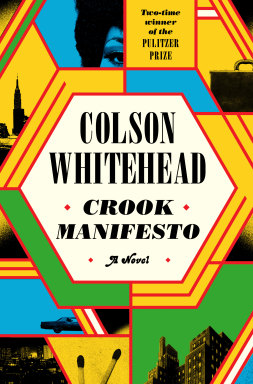Superior thrills in Colson Whitehead’s cracking crime caper
Save articles for later
Add articles to your saved list and come back to them any time.
FICTION
Crook Manifesto
Colson Whitehead
Fleet, $32.99
Colson Whitehead is known for trying out new things, but in Crook Manifesto the new thing he tries out is a return to an old thing. He’s written a sequel to his last book, Harlem Shuffle, a ’60s-set crime yarn centring on the full-time furniture salesman and part-time fence, Ray Carney, whose aspirational right hand tried to pretend it didn’t know what his other, grimier hand was doing.
Superior thrills ensued: Whitehead had perfected the art of combining historical crime fiction and the social novel, and it’s not surprising he wanted to continue in this vein. With material this rich it was hard to believe Harlem Shuffle was the last we would hear of those characters and that world.
In his latest novel Colson Whitehead tries something new – a sequel to his previous work, Harlem Shuffle.Credit: Simone Padovani
Harlem Shuffle left off in 1964; Crook Manifesto picks up the thread in 1971, the start of the decade that made New York a byword for squalor and danger, a period now grown so distant it has become an object of dark nostalgia – SoHo! Times Square! Chelsea Piers! – like Weimar Berlin or Victorian London. (See The Deuce; see The Flamethrowers.)
Whitehead doesn’t indulge his nostalgia, and Crook Manifesto hasn’t quite the high spirits of its predecessor: fedoras and faux fur notwithstanding, not to mention black power, one would have to be nihilistically, even psychopathically keen on the aesthetics of decay to get much joy from ’70s Harlem. The book is still highly readable, though, just not quite as much fun. If Harlem Shuffle was a caper, Crook Manifesto is an apocalypse.
Colson Whitehead’s latest novel.Credit:
It has the same tripartite structure as its predecessor, with three different, related stories in each section and each section jumping forward a couple of years. When the first opens Carney has gone straight, and thinks the word is out. He doesn’t know, though, what every consumer of crime fiction knows: when a character announces he is out of the life, he is begging the plot to drag him back in. His old connection in the NYPD, Munson, does know this. “Crooked stays crooked, and bent hates straight”, and Munson isn’t interested in any new leaf Carney might have turned.
The corruption in the force has become unignorable, at last. Clean cop Frank Serpico, soon to be incarnated by Al Pacino in a hit film, has blown the whistle, the subpoenas are raining down like confetti, and one has landed on Munson. He has decided he needs Carney’s help to organise his escape from New York, and Carney goes along with it for the best family man reasons: Munson can get him all-but-unobtainable tickets to the Jackson Five concert Carney’s daughter wants to go to. (Fewer high spirits, perhaps, but Crook Manifesto isn’t solemn either.)
For the middle section Whitehead starts to get meta. It’s 1973. Zippo, the blue photographer from Harlem Shuffle, has resurfaced as a blaxploitation movie director, and is filming scenes from Code Name: Nefertiti in Carney’s showroom. Lucinda Cole, no more than a name in the previous novel, here stars in the movie and on the page.
It’s the moment of a new form of black celebrity, race-conscious and undeferential: woke, in fact, in the original sense of the word. Along with Zippo and Cole we are introduced to a hip young black comedian, Roscoe Pope – initials shared with Richard Pryor – wowing whitey with his jive in clubs down the Village. Whitehead makes sure to note that this flowering of black male pride comes with a sizeable dollop of misogyny: Pope is charismatic and funny, but some of his behaviour is pretty unsavoury.
Carney just about vanishes from the second section, and Whitehead gives the book over to its most compelling character, the small-time hood and hired muscle, Pepper. Stoical and dour and a bit on the mean side (“I like plenty of folks, I just don’t like people”), he looks askance at pretty much everything, from the younger generation of blacks “with their eye-melting clothing and their tiresome, uplifting slogans”, to the white hippie freaks working on Zippo’s movie: “Frankly, the racial harmony shit put Pepper on edge.”
For much of the second and third parts Pepper is our guide, an ornery Virgil leading the reader through this borough of the inferno. He is a deflationary contrast to the blaxploitation flicks’ superheroes – and to lairs such as Roscoe – though, in his own way, he is as stylised a figure as John Shaft or Superfly’s Youngblood Priest (well, maybe not that stylised).
An inferno it is. This was the era when whole blocks in Harlem and the Bronx ended up torched for the insurance, and because the city would give you a new apartment if you got burnt out of your slum. In part three, when the flames get too close to home, Carney is roused to action. Like Pam Grier in Coffy going after the pushers who got her little sister hooked, Carney won’t stop until someone has been made to pay. But eventually we see beyond even the graft: not this bent cop – a whole lot of bent cops – or that bent politician, but unintended consequences and dodgy research, with its skewed rubrics and dirty data. Spoiler alert: it was the think tanks all along.
The Booklist is a weekly newsletter for book lovers from books editor Jason Steger. Get it delivered every Friday.
Most Viewed in Culture
From our partners
Source: Read Full Article

